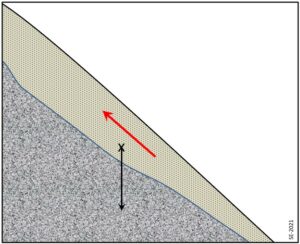Chapter 5 Summary and Questions for Review
The topics covered in this chapter can be summarized as follows:
| 5.1 Factors that Control Stability on Slopes | Slope stability is controlled by the slope angle and by the strength of the materials on the slope. Slope is a product of tectonic uplift, and strength is determined by the type of material on the slope and also by its water content. Rock strength varies widely and is also determined by internal planes of weakness and their orientation with respect to the slope. In general, the more water, the greater the likelihood of failure. This is especially true for unconsolidated sediments, where excess water will push the grains apart. Addition of water is the most common triggers of mass wasting, by storms, rapid melting or flooding. |
| 5.2 Classification of Mass Wasting | The key criterion for classifying mass wasting is the nature of the movement that takes place. This may be a precipitous fall through the air, sliding—as a solid mass—either along a plane or a curved surface, or internal flow—as a viscous fluid. The type of material that moves is also important—specifically whether it is solid rock or unconsolidated sediments. The important types of mass wasting are creep, slump, translational slide, rotational slide, fall, and debris flow or mud flow. |
| 5.3 Mitigating the Effects of Mass Wasting | We cannot prevent mass wasting, but we can delay it through efforts to strengthen the materials on slopes. Strategies include adding mechanical devices such as rock bolts, or ensuring that water can drain away. Such measures are never permanent. We can also avoid practices that make matters worse, such as cutting into steep slopes or impeding proper drainage. In some situations, the best approach is to mitigate the risks associated with mass wasting by constructing shelters or diversionary channels. And in some cases, where slope failure is inevitable and unpredictable, we simply need to stay out of the way. |
| 5.4 Mass Wasting and Earth Systems | The potential for mass wasting is both increased and decreased by various Earth system processes. Mass wasting also contributes to other Earth systems processes. |
Review Questions for Chapter 5
Answers for the review questions can be found in Appendix 1
-

(Steven Earle, CC BY 4.0) In the scenario depicted to the right, the gravitational force on the unconsolidated sediment overlying the point marked with an x is depicted by the black arrow. Draw in the two arrows that show how this force can be resolved into the shear force (along the slope) and the normal force (into the slope).
- The red arrow depicts the shear strength of the sediment. Predict whether this material is likely to fail or not.
- After several days of steady rain, the sediment becomes saturated with water and its strength is reduced by 50%. What are the likely consequences of this?
- In the diagrams below, a road cut is constructed in sedimentary rock with well-developed bedding. On the left hand side draw in the orientation of the bedding that would represent the greatest likelihood for slope failure. On the right show the orientation that would represent the least likelihood for slope failure.

(Steven Earle, CC BY 4.0) - Explain why moist sand is typically stronger than both dry sand and saturated sand.
- In the context of mass wasting, how does a “flow” differ from a “slide”?
- If a large rock slide starts moving at a rate of several m/s, what is likely to happen to the rock, and what would the resulting failure be called?
- In what ways does a typical debris flow differ from a typical mud flow?
- In the situation described above regarding lahar warnings around Mt. Rainier, the residents of the affected regions have to assume some responsibilities for their own safety. What sort of preparation should the residents take in order to ensure that they can respond appropriately when they hear lahar warnings?
- What is the most likely negative slope-failure implication of the construction of house at the top of a potentially unstable cliff?
- Explain how mass wasting might lead to a change in the sediment load of a stream.
